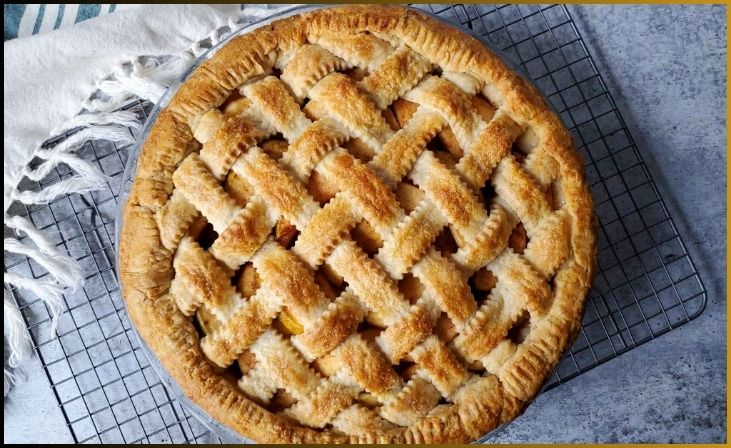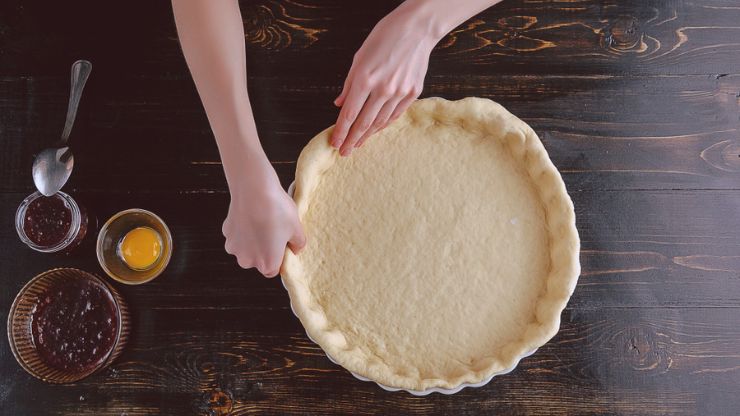Delving into the world of pie baking is a delightful journey, and if you’re looking to add a unique twist to your creations, a sourdough pie crust is a game-changer. Its distinct tangy flavor and exceptional texture can elevate your pies to new heights. In this blog, we’ll unravel the art of crafting a fail-proof sourdough pie crust, ensuring that your pies are not just delicious but also unique in taste and texture.
Sourdough’s natural fermentation brings a subtle tang that beautifully complements various fillings, be it sweet or savory. The magic lies in the wild yeast and lactic acid bacteria, which create a tender, flaky crust that’s more digestible, even for those with mild gluten sensitivities. With just a few easy-to-follow steps, you can master this essential pie-making skill and bring a whole new dimension to your baking endeavors. So, let’s roll up our sleeves and explore the secrets of creating a sourdough pie crust that’s truly fail-proof.
Table of Contents
ToggleThe Allure of Sourdough Pie Crust

Before diving into the step-by-step process, let’s explore why sourdough pie crusts are worth the effort. Sourdough brings several advantages to the world of pie baking:
- Flavor Enhancement: Sourdough’s natural fermentation imparts a subtle tang that beautifully complements both sweet and savory fillings.
- Improved Texture: The presence of wild yeast and lactic acid bacteria in sourdough creates a tender, flaky crust with a delightful chew.
- Reduced Gluten Sensitivity: Sourdough fermentation can break down gluten, making the crust easier to digest for those with mild gluten sensitivities.
- Enhanced Nutrition: Sourdough also increases the availability of nutrients in the flour, resulting in a more nutritious pie crust.
Now that you’re convinced of the merits of a sourdough pie crust, let’s get started.
Also Read- Healthy Sourdough Starter: The Heart of Artisanal Bread
Ingredients for Sourdough Pie Crust
To create a fail-proof sourdough pie crust, you’ll need the following ingredients:
- 1 cup all-purpose flour
- 1/2 cup unsalted butter (cold and cut into small pieces)
- 1/2 cup active sourdough starter
- 1 teaspoon salt
- 1 teaspoon sugar (for sweet pies, optional)
- 2-3 tablespoons ice-cold water
Step 1: Prepare Your Sourdough Starter
Before embarking on crafting a sourdough pie crust, ensure your sourdough starter is active and at room temperature. If stored in the refrigerator, allow it to reach room temperature for a couple of hours. An active starter is essential as it provides the leavening power needed for a successful pie crust. If you haven’t fed your starter in a while, give it a good feeding a day or two before you plan to make the pie crust to ensure it’s at its peak of activity.
Step 2: Combine Dry Ingredients
In a mixing bowl, combine your dry ingredients. This typically includes 1 cup of all-purpose flour, 1 teaspoon of salt, and optionally, 1 teaspoon of sugar if you’re making a sweet pie crust. Whisk them together thoroughly. The dry ingredients serve as the foundation for your sourdough pie crust and should be evenly distributed before proceeding to the next steps.
Step 3: Cut in the Butter
Next, add 1/2 cup of cold, unsalted butter that you’ve cut into small pieces to the dry ingredients. Using a pastry cutter or your fingertips, quickly work the butter into the flour mixture. The goal is to create a crumbly texture with pea-sized pieces of butter. This step is crucial for achieving a flaky pie crust, as the small bits of butter will melt during baking, creating pockets that give your crust its characteristic flakiness.
Don't just scroll, subscribe!
BuzzTrail's unique web-stories are the cure for boredom you've been waiting for.
Step 4: Mix in the Sourdough Starter
Now, incorporate 1/2 cup of your active sourdough starter into the mixture. Gently combine the starter with the dry ingredients without overmixing. You want to maintain visible streaks of butter in the dough for that flaky texture. The sourdough starter will not only enhance the flavor but also contribute to the tenderness of your pie crust. Handle the dough with care to avoid overworking it and developing excessive gluten, which can result in a tougher crust.
Step 5: Add Ice-Cold Water
Gradually add 2-3 tablespoons of ice-cold water, one tablespoon at a time, to the dough. You should add just enough water to make the dough start coming together while using as little as possible. Overmixing or adding too much water can make the crust tough, so be careful to maintain the right consistency. This step helps bind the ingredients together, ensuring your sourdough pie crust holds its shape while maintaining its flakiness.
Step 6: Shape the Dough
Transfer the dough to a lightly floured surface and gently shape it into a ball. Flatten the ball into a disc, wrap it in plastic wrap, and refrigerate it for at least an hour (or up to 24 hours). This resting period allows the dough to hydrate and relax, making it easier to roll out without shrinking back when you’re ready to use it. Properly shaping and resting the dough are key to achieving a tender, flaky sourdough pie crust.
Step 7: Roll Out, Line the Pan, and Bake
After the dough has chilled, remove it from the refrigerator and let it sit for a few minutes to become pliable. On a floured surface, roll out the dough into a circle that’s about 1/8-inch thick. Carefully transfer it to your pie pan, pressing it evenly to cover the bottom and sides. Trim any excess overhang, and you’re ready to fill and bake your pie according to your recipe’s instructions. Rolling out the dough and lining the pan is the final step to complete your sourdough pie crust, which will add a wonderful dimension to your pies with its unique flavor and texture.
Tips for Success
- Keep Ingredients Cold: Cold ingredients are key to achieving a flaky crust. Use cold butter and ice-cold water, and refrigerate the dough as directed.
- Don’t Overwork the Dough: Overmixing or over-kneading the dough can make it tough. Handle the dough gently and aim for a crumbly texture.
- Use a Scale: Weighing your ingredients ensures accuracy and consistency in your pie crust.
- Experiment: Feel free to experiment with different flours (whole wheat, rye, etc.) for unique flavor profiles.
- Practice Patience: Allowing the dough to rest and chill between steps is essential for a tender, flaky crust.
For More- Plain ‘Ole, Basic Sourdough Bread
Conclusion
As we conclude our journey into the realm of sourdough pie crusts, it’s evident that this art is both attainable and rewarding. Crafting a fail-proof sourdough pie crust opens up a world of culinary possibilities, elevating your pies to an extraordinary level of flavor and texture.
Sourdough’s natural fermentation brings that sought-after tanginess and tenderness, making your pies stand out from the rest. Moreover, it’s an excellent option for those looking to reduce gluten sensitivity in their baking.
With the right ingredients, a bit of practice, and a dash of patience, you can master the technique of creating a perfect sourdough pie crust. As you experiment with different fillings and variations, you’ll discover the endless potential of this extraordinary crust.
FAQs
Can I use a sourdough discard for my pie crust?
Can I use a sourdough discard for my pie crust?
Yes, you can use sourdough discard, but it might have a milder flavor. Ensure it’s active discard.
What if my sourdough pie crust is too crumbly or dry?
What if my sourdough pie crust is too crumbly or dry?
Add a little more water, a teaspoon at a time, until the dough holds together without overworking it.
Can I make a gluten-free sourdough pie crust?
Can I make a gluten-free sourdough pie crust?
Yes, you can use gluten-free flour blends to create a gluten-free sourdough pie crust.
Do I need to refrigerate the dough before rolling it out?
Do I need to refrigerate the dough before rolling it out?
Chilling the dough is essential for flakiness. Refrigerate it for at least an hour before rolling.

